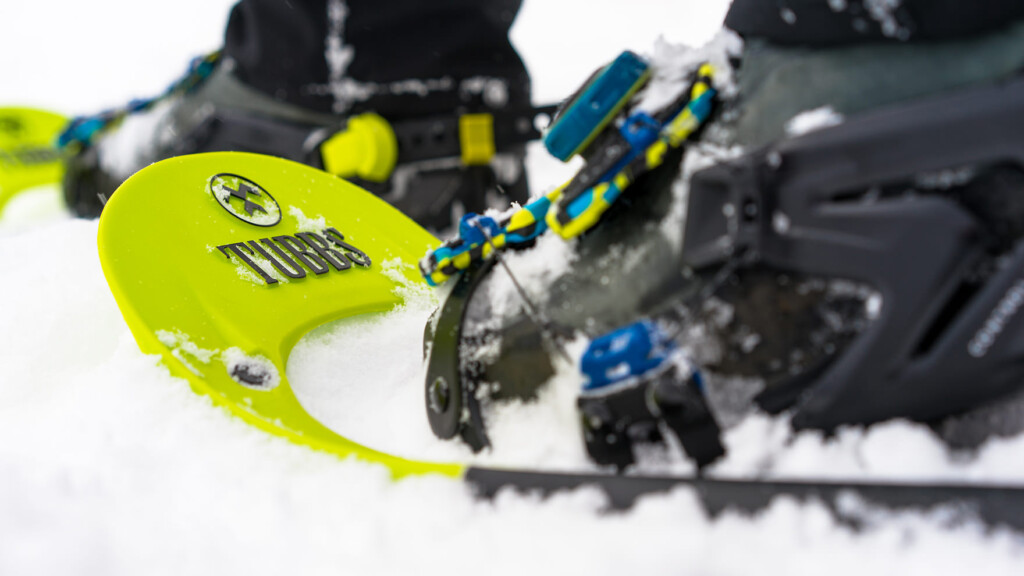
Comparison of lineup: We've compared TUBBS snowshoes, a long-established brand that never stops innovation, so we'll introduce some recommended models.
We will continue to offer trial wear of representative models from major snowshoe brands. In the third installment, we will report on TUBBS, a pioneer in the snowshoe industry that has been in business for over 100 years in Maine, USA.
This time we've picked out the popular "FLEX" plastic deck series from TUBBS's wide lineup. We borrowed five models with different uses and styles from some manufacturers, including walking to backcountry (hereinafter referred to as BC), and gender, and tried them on (@Kagura Ski Resort). As usual, the discussion from here is based on the assumption that you have some knowledge about snowshoes. If you are reading this and finding some parts that are difficult to understand, please also read the following article, which I previously explained and reviewed on how to choose snowshoes.
- Once you know it, you can't stop! Three points to know when choosing snowshoes: How to choose snowshoes
- Comparison review: Comparing shoes from the four major snowshoe manufacturers, MSR, ATLAS, TSL, and TUBBS!
table of contents
- table of contents
- Features and lineup comparison of TUBBS snowshoes
- About the FLEX series I tried on this time
- Differences in bindings (how to put on and take off) - The Boa closure that you can wear quickly is too godlike -
- Differences in buoyancy - The deck structure and size of all models are almost the same
- Differences in grips: VRT's unpleasant front nails perform better than expected
- Differences between male and female models
- Introducing recommended TUBBS snowshoe models for each scene
table of contents
Features and lineup comparison of TUBBS snowshoes
I'd like to leave aside the functions that I'm not going to talk about, and first say it. It's just about the appearance, but the design makes you think, "I want it... I really want it!" Rather than climbing the mountain, I personally find the sophisticated deck design and coloring that stands out on the slopes, as well as the bindings with an incredible "gear" feel and the texture of the blades (crampons). In terms of design alone, it's not only cool as a standalone, but when combined with BC-type equipment, it just couldn't be better suited.
Until I first met this brand, I always thought it was a guy who "snowboard brands have been making cool things with great energy," but when I opened it up, it's a long-established, hard-working company founded in 1906. This is the manufacturer that made plain snow walking equipment using wood and leather lace up until just over 20 years ago. It may also be that the current management is under the umbrella of the K2 Group.
In any case, I believe that this brand's refreshing attitude, despite carrying tradition, never forgetting to take on challenges, is another aspect of its functionality.
About the FLEX series I tried on this time
Now, finally the main topic. The FLEX series I will be discussing now is a series that uses a plastic deck that is durable enough for moderate flexibility and flexibility among TUBBS's diverse lineup. It features the "FLEX Tail" designed based on ergonomics and biomechanics, allowing for natural and smooth walking while reducing the burden on joints. We will now look at the characteristics of each model, focusing on the commonalities and differences, but we will take a rough overview of the indicators and specs in advance in the table below to make them easier to understand. There are other models made from aluminum frames at TUBBS, but please understand that this discussion is not taken into consideration.
| item | FLEX VRT SNOWSHOE | FLEX RDG SNOWSHOE | FLEX ESC SNOWSHOE |
|---|---|---|---|
| image |  FLEX VRT SNOWSHOE |  FLEX RDG SNOWSHOE |  FLEX ESC SNOWSHOE |
| Suitable activities | Backcountry | Day hiking | Trail walking |
| Specialty terrain | Mountains | Rolling terrain | Flatland |
| grip | ◎ | ◯ | ◯ |
| buoyancy | ◎ | ◎ | ◎ |
| Ease of putting on and taking off | ◎ | ◯ | ◯ |
| Ease of adjustment | ◎ | △ | ◎ |
| Fixed force | ◯ | ◯ | ◎ |
| Ease of walking | ◯ | ◯ | ◯ |
| The fun of the descent | ◯ | ◯ | ◯ |
| Toe adjustment | ◎DYNAMICFIT BINDING | ◎CUSTOMWRAP BINDING | ◯QUICKFLEX BINDING |
| Ankle strap | ◎One-touch strap | △Steel pin | ◯Strap |
| Front nail | ◎VIPER 2.0 CRAMPON | ◯ | ◯ |
| Blade Clampon | ◎TRACTION RAILS (deep) | ◯TRACTION RAILS | ◯TRACTION RAILS |
| Climbing support | ◎(High) | ◯ | ◯ |
| Size (cm) | 21 x 61 (24 inches) | 21×61 | 21×61 |
| Weight (g) | 2040 (24 inch) | 1750 | 1632 |
| Size variations | 24/28 inch | 24 inches | 24 inches |
Differences in bindings (how to put on and take off) - The Boa closure that you can wear quickly is too godlike -
Of course, there are many reasons to choose TUBBS, even outside of design. One of the most attractive features of this binding is the Boa Closure System, which was developed in 1998 for snowboard boots, which uses an ultra-fine wire and a dial fastener.
This mechanism is used in two models, VRT and RDG Once you've stuck your toes into the binding, all you have to do is turn the dial, and there's no need to put any force into it. You can wear it with one hand and with gloves on, surprisingly smoothly and quickly.

The ESC (left) is tightly tightened with a tape strap, making it fits a variety of shoes and is highly versatile. In the RDG (medium), the wire on the instep connects to the strap on the heel, so just tightens the entire body, but it is less flexible. The VRT (right) has the impression that it was easy to put on and take off and the fastening power was high.
However, even when the same Boa is adopted, there are subtle differences in mechanisms, so some additional information is needed. The RDG binding has wires connected to the heel, so by tightening the dial on the instep, the entire heel can be tightened, making it literally a one-touch detachable structure (center of the photo below). On the other hand VRT , only the instep can be tightened using the dial, and another rubber strap must be tightened to secure the heel (right in the photo below).
RDG clearly easier, but RDG , you need to adjust the length of the heel strap in advance to suit your shoes, which is a bit disappointing that this adjustment is a bit troublesome, with two hard steel pins pulled out with your fingers and re-setting them. Furthermore, the RDG is slightly less flexible, so depending on the boot, you may be concerned about the slightest space (although there may be individual differences), and in terms of fixation, VRT is more secure in place by pressing the entire foot evenly.
the VRT is smartly designed so that it can be secured to the perfect point just by pulling it, so it doesn't actually feel like a hassle, and to be honest, it's quite easy to use . When I consider these points, I personally prefer VRT

The ESC (left) is a very common strap and is a bit prone to coming off. RDG (medium) is a steel pin that cannot be easily adjusted. The VRT (right) is a convenient strap that automatically holds and secures it by simply pulling.
ESC that does not use Boa has a structure that fastens two points: a simple synthetic strap and a heel strap. Although it is slightly inferior to other models in terms of effort to put on and take off (the difference between simply turning the dial with one hand or pulling the strap with both hands), the mechanism itself is the same, where you thrust the toes and tighten them, so it's not that different in terms of speed.
The flexible tape straps are easy to match not only with hard shoes such as skis, snowboard boots and alpine boots, but also with soft shoes such as snow boots, so if you want to enjoy it with light equipment, it would be better to force yourself the ESC the TREK with similar structures, which I haven't tried this time .
Differences in buoyancy - The deck structure and size of all models are almost the same
As you can see in the photo below, the size and shape of the deck (and material) are almost the same, so the difference between each model was not clear enough to be seen. Originally, the FLEX series is the smallest size of 24 inches (22 inches for female models). Snowshoes, which were developed to walk through the flat dry snow fields and forests of the North American continent, are originally well-known for their high buoyancy, and I think you can certainly feel the difference from those who use around 22 inches by other manufacturers such as MSR.
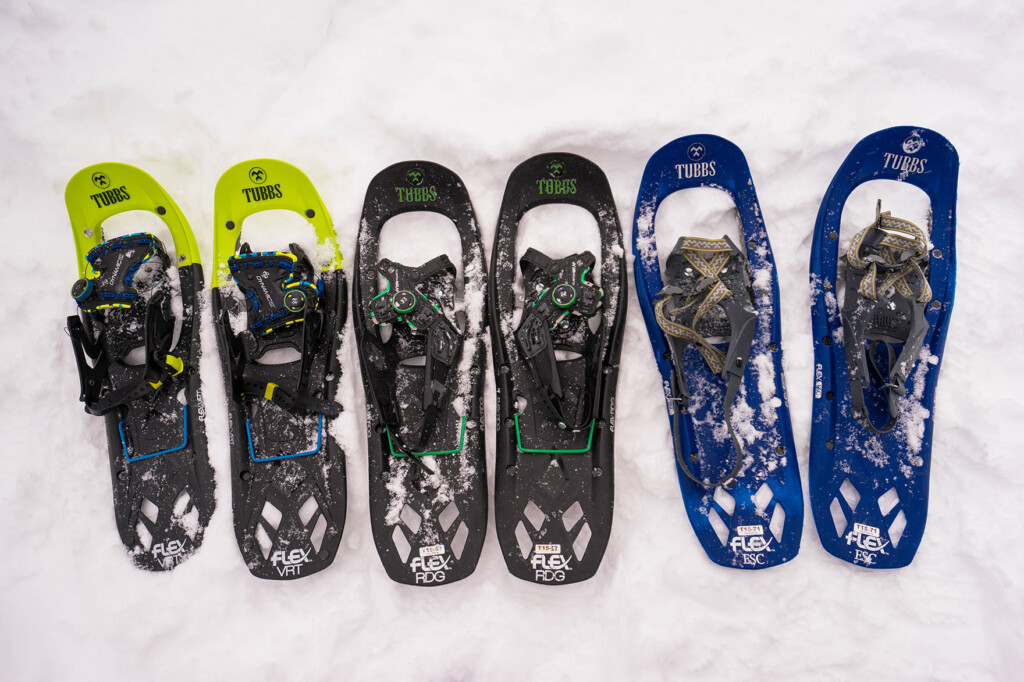
Comparing the appearance of the FLEX series, VRT, RDG, and ESC from left to right. The deck size and shape (and material) are almost the same.
Differences in grips: VRT's unpleasant front nails perform better than expected
Next, turn the snowshoes over and look around the grips of blades, clamps, etc. the RDG and ESC is exactly the same as the view and the feeling of walking. On the other hand, the vertical blades of the VRT When this is brought forward to a steep slope with tight snow, the stability of the front claws is extremely strong after applying load. Furthermore, the heel lift (climbing support) is set slightly higher, and as the name VRT = Vertical suggests, these features are said to be ideal for backcountry scenes where they face harsh slopes.
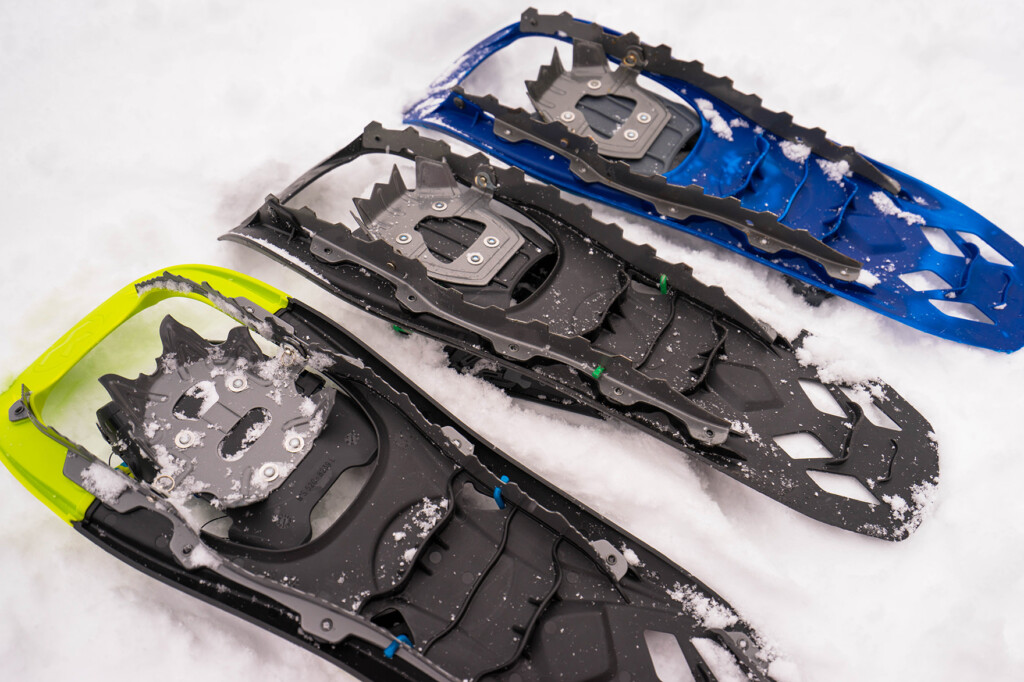
Comparison of the blade and clamp on the back. All of them felt a solid grip, but when the slopes hit a sharp slope, the VRT won by a landslide.
ESC is intended for walking on flat snowy fields, does not have a heel lift, so this model is not suitable for walking on courses that often climb and descend on steep slopes, so you need to be careful about this.
Differences between male and female models
At the end of the points, I was able to try out the male and female models of RDG and ESC this time, so I also checked out the differences between these.
Firstly, the sizes vary clearly depending on the male and female model. It may be hard to see in the photo, but the male model is 24 inches and the female model is 22 inches. Furthermore, the size has not only been shortened, but also the deck shape is slightly more rounded and less likely to get caught, and the binding shape (size?) is tailored to the size of women's shoes. Although female models have structural adjustments to suit their body shape, there is no difference in basic functions and usability. On the other hand, if a petite man actually fits it in and it fits in, it's fine to use a female model.

Comparison of ESC male models (right) and ESC female models (left). At first glance, it's hard to tell the difference, but there are subtle differences in size and shape.
Introducing recommended TUBBS snowshoe models for each scene
Taking these features into consideration, we will introduce some recommended models that are particularly easy to use in the TUBBS series.
Smooth attachment and removal and abundant buoyancy and traction are recommended for backcountry: FLEX VRT
It's been two years since TUBBS started using Boa closures, and it was a little bit like buying a jacket. The Boa binding, which can be firmly fixed in seconds, is so comfortable that once you have tried it you will not be able to go back to other models. Boa has been a type of sceptical person who is skeptical of new things, but for now, it has never even broken or sluggished. Of course, there is a psychological anxiety that it is a bit scary to use it roughly.
On the other hand, this is just my personal impression, but it is just one step closer to the MSR in terms of weight and grip, and is competing with ATLAS in terms of buoyancy and ease of attachment and removal, and is a good match for the TSL in terms of ease of walking. If you think about it this way, if you say that it is overwhelmingly superior to flagship models from other brands, this is definitely the case! That may not have the advantage. However, on the other hand, I think the advantage of this model is that "every element competes with the top" and that it is a final candidate no matter what situation it is used in. It boasts performance that is free from above the standard in terms of buoyancy, grip, ease of walking, and ease of use, and is also affordable. This sophisticated design keeps you from anywhere, so it's impossible for climbers and BC players to try to break into deep snow.
However, if I had to say that it is relatively large, so if you want to go with a lighter and more compact suspension, or if you want to go with a route that frequently has a varied, harsh slope, such as traverses on crusted slopes rather than deep snow, or for seasons where the temperature rises and the snow becomes tighter and heavier, you can rest assured. On the other hand, in backcountry during the harsh winter when it comes to powder, its almighty performance and ease of use will probably provide maximum performance.
Perfect for snow hiking in snow fields with high cost performance and perfect for your first pair: FLEX ESC
As I wrote when introducing TSL, if someone with little experience in snow hiking or snowshoeing wants to explore a trail with snow first, sharp, deep blades and heavy bindings are not required, so a simpler, easier to use, lower-priced models are best. However, snowshoes have become more expensive recently, and it is currently difficult to reach even at low prices for proven manufacturers. For those of you who are like that, this FLEX ESC is the gospel.
Even if it gets rotten, the FLEX series uses cutting-edge technology to create a very stable grip, buoyancy and easy to walk in, making it as comfortable as a VRT on flat ground. Furthermore, as a result of simplifying unnecessary parts, the weight has also been significantly reduced (1632g). If it is available at this price, it can only be said that it is one of the highest cost-effective models of all the entry models up to now. I'd like to try walking around Migahara wearing these. If you could do that under the blue sky for the first time, even the lightest hikers would be sure to get hooked on snowy mountains and marsh.
We also recommend this article about snowshoes.
- Once you know it, you can't stop! Three points to know when choosing snowshoes: How to choose snowshoes
- Comparison review: Comparing shoes from the four major snowshoe manufacturers, MSR, ATLAS, TSL, and TUBBS!
- Lineup comparison: We compared MSR snowshoes, so we'll introduce some recommended models.
- Comparison of lineup: We've compared TSL snowshoes, a talented person only knows, so we'll introduce some recommended models.


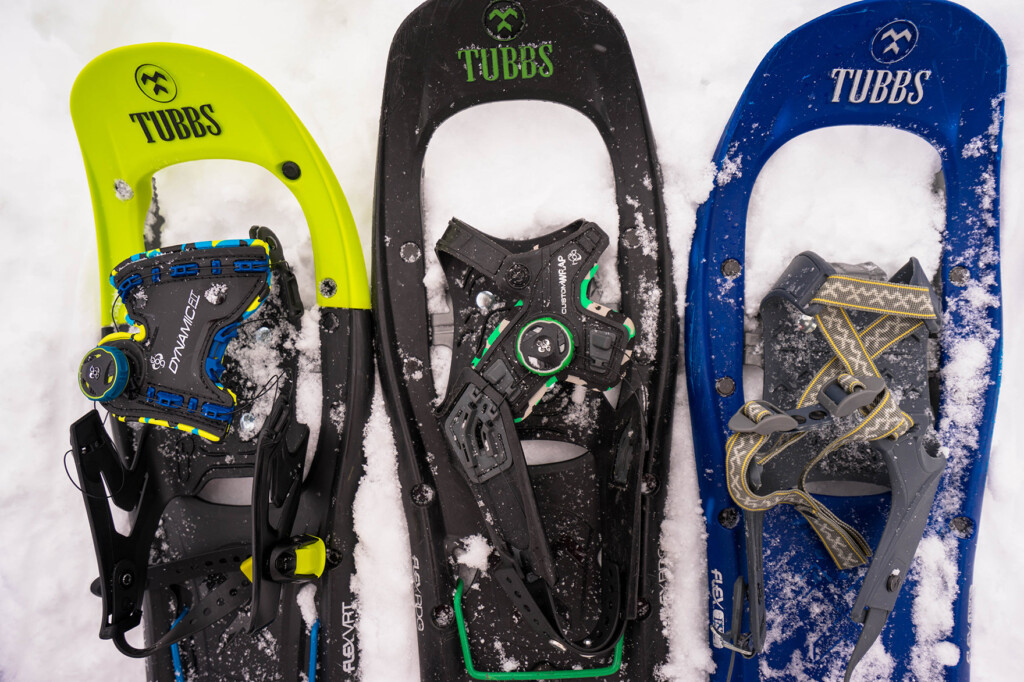
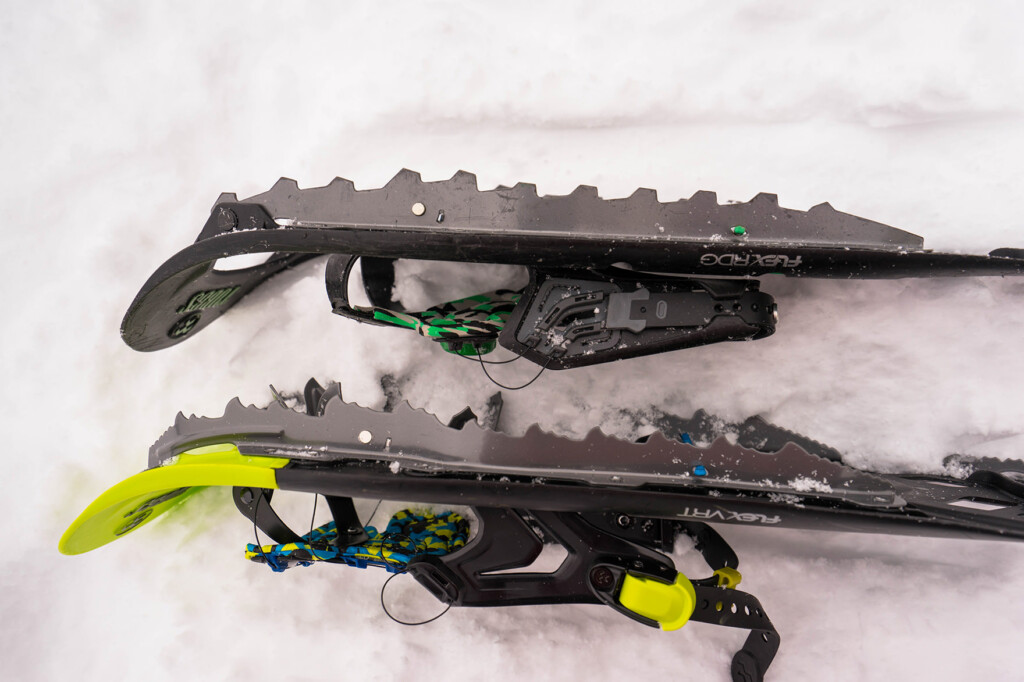
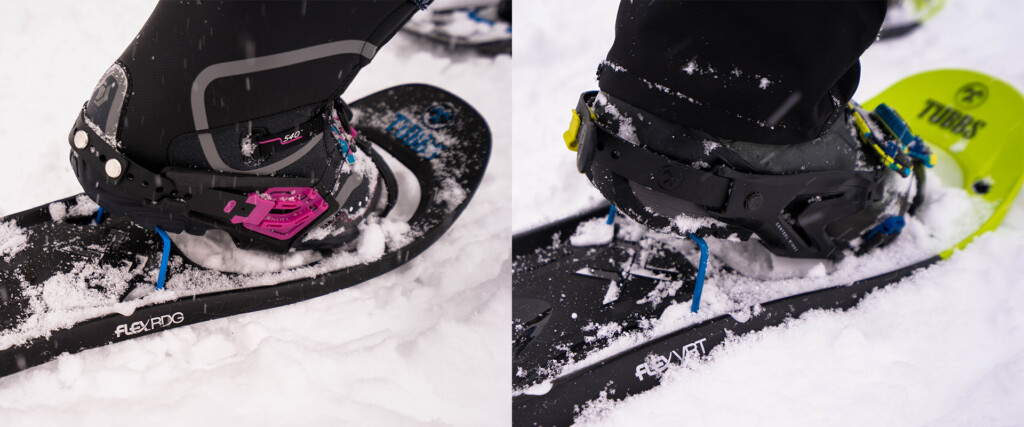

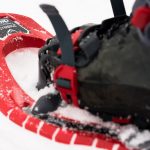 Comparison of lineup: We've compared TSL snowshoes, a talented person only knows, so we'll introduce some recommended models.
Comparison of lineup: We've compared TSL snowshoes, a talented person only knows, so we'll introduce some recommended models.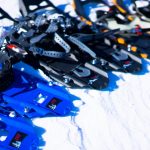 Lineup comparison: We compared MSR snowshoes, so we'll introduce some recommended models.
Lineup comparison: We compared MSR snowshoes, so we'll introduce some recommended models.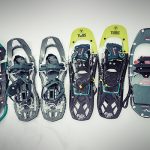 Comparison review: Comparing shoes from the four major snowshoe manufacturers, MSR, ATLAS, TSL, and TUBBS!
Comparison review: Comparing shoes from the four major snowshoe manufacturers, MSR, ATLAS, TSL, and TUBBS!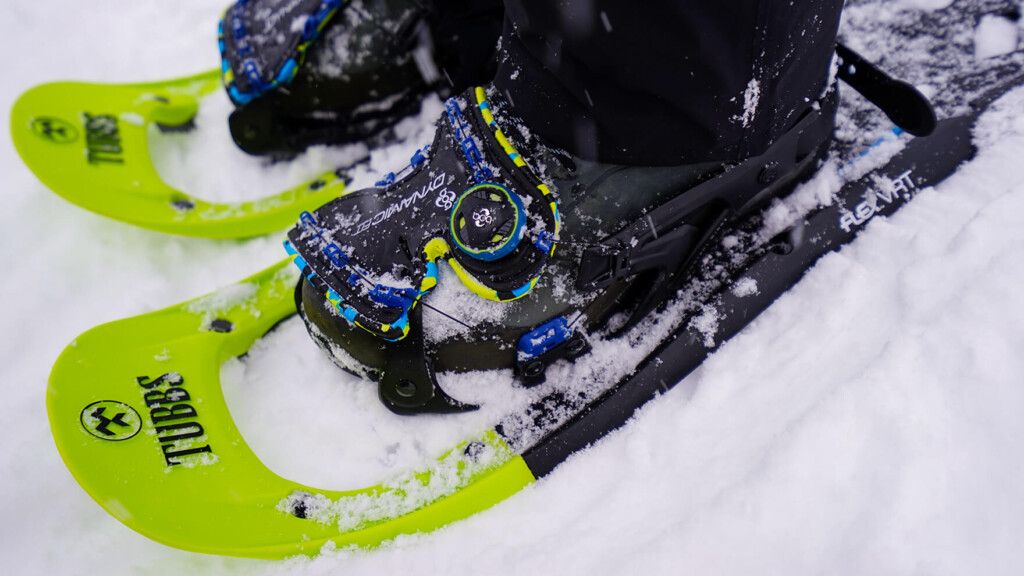 From snow hiking to backcountry. The entrance to the wonderful snowy mountains, how to choose snowshoes wisely and 5 recommended models
From snow hiking to backcountry. The entrance to the wonderful snowy mountains, how to choose snowshoes wisely and 5 recommended models